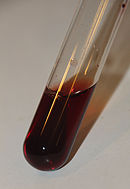Neutral red

| |||
| |||
| Names | |||
|---|---|---|---|
| IUPAC name
N2,N2,7-Trimethylphenazine-2,8-diamine—hydrogen chloride (1/1)
| |||
| Other names
3-Amino-7-dimethylamino-2-methylphenazine hydrochloride
Toluylene red | |||
| Identifiers | |||
3D model (JSmol)
|
|||
| ChEBI | |||
| ChemSpider | |||
| ECHA InfoCard | 100.008.215 | ||
| EC Number |
| ||
PubChem CID
|
|||
| UNII | |||
CompTox Dashboard (EPA)
|
|||
| |||
| |||
| Properties | |||
| C15H17N4 | |||
| Molar mass | 288.78 g/mol | ||
| Melting point | 290 °C (554 °F; 563 K) | ||
| Hazards | |||
| GHS labelling: | |||
  
| |||
| Danger | |||
| H301, H315, H319, H335, H341 | |||
| P201, P202, P261, P264, P270, P271, P280, P281, P301+P310, P302+P352, P304+P340, P305+P351+P338, P308+P313, P312, P321, P330, P332+P313, P337+P313, P362, P403+P233, P405, P501 | |||
Except where otherwise noted, data are given for materials in their standard state (at 25 °C [77 °F], 100 kPa).
| |||
| Neutral red (pH indicator) | ||
| below pH 6.8 | above pH 8.0 | |
| 6.8 | ⇌ | 8.0 |
Neutral red (toluylene red, Basic Red 5, or C.I. 50040) is a eurhodin dye used for staining in histology. It stains lysosomes red.[1] It is used as a general stain in histology, as a counterstain in combination with other dyes, and for many staining methods. Together with Janus Green B, it is used to stain embryonal tissues and supravital staining of blood. It can be used for staining the Golgi apparatus in cells and Nissl granules in neurons.
In microbiology, it is used in the MacConkey agar to differentiate bacteria for lactose fermentation.
Neutral red can be used as a vital stain.[2] The Neutral Red Cytotoxicity Assay was first developed by Ellen Borenfreund in 1984. In the Neutral Red Assay live cells incorporate neutral red into their lysosomes. As cells begin to die, their ability to incorporate neutral red diminishes. Thus, loss of neutral red uptake corresponds to loss of cell viability.[3] The neutral red is also used to stain cell cultures for plate titration of viruses.
Neutral red is added to some growth media for bacterial and cell cultures. It usually is available as a chloride salt.
Neutral red acts as a pH indicator, changing from red to yellow between pH 6.8 and 8.0.
References
[edit]- ^ Winckler, Jürgen (1973). Vitalfärbung von Lysosomen und anderen Zellorganellen der Ratte mit Neutralrot [Vital staining of lysosomes and other cell organelles of the rat with Neutral red]. Progress in Histochemistry and Cytochemistry (in German). Vol. 6 (3). Gustav Fischer Verlag. pp. 1–91. doi:10.1016/S0079-6336(74)80001-X. ISBN 3-437-10353-9. PMID 4142096.
- ^ Repetto, Guillermo; del Peso, Ana; Zurita, Jorge L. (2008). "Neutral red uptake assay for the estimation of cell viability/cytotoxicity". Nature Protocols. 3 (7): 1125–1131. doi:10.1038/nprot.2008.75. PMID 18600217. S2CID 24676983.
- ^ Borenfreund, Ellen; Puerner, James A. (1984). "A simple quantitative procedure using monolayer cultures for cytotoxicity assays (HTD/NR90)". Journal of Tissue Culture Methods. 9 (1): 7–9. doi:10.1007/BF01666038.
Other references
[edit]- Borenfreund, Ellen; Puerner, James A. (1985). "Toxicity determined in vitro by morphological alterations and neutral red absorption". Toxicology Letters. 24 (2–3): 119–124. doi:10.1016/0378-4274(85)90046-3. PMID 3983963.
- Borenfreund, E.; Babich, H.; Martin-Alguacil, N. (1988). "Comparisons of two in vitro cytotoxicity assays—The neutral red (NR) and tetrazolium MTT tests". Toxicology in Vitro. 2 (1): 1–6. doi:10.1016/0887-2333(88)90030-6. PMID 20702351.


